How to plant, grow, and care for sunflowers — and harvest their seeds
Sunflowers grow large, tall, and cheerful flower heads that brighten and animate your yard—and though you most commonly see these aptly-named beauties in sunny yellow, the annuals can be red or orange, too. There are so many good reasons to grow them, beyond the fact that they make you happy: They're easy to cultivate, attract beneficial pollinators like butterflies and native bees, and draw beautiful songbirds (many species love these blooms!).
You also don't need a sprawling field to make them grow: "Sunflowers can be grown directly in the ground or started in pots and kept as container plants, which is a great way to extend their season in cooler climates," says Stephen McFarlane, regional landscaping manager of Sandals Resorts. Here, learn how to plant, grow, and care for these summertime show-stoppers (and harvest their seeds at the end of their lifecycle!).
Related: 12 Annual Flowers That Bloom All Summer Long
How to Plant Sunflowers
Sunflowers are one of the easiest annual flowers to start from seeds. "You can germinate them indoors in pots or directly in the garden," says Elle Meager, a permaculture teacher and the founder and CEO of Outdoor Happens. "I prefer direct sowing them outdoors. However, germinating the seeds indoors has advantages if you have a short growing season."
Planting Sunflower Seeds Outdoors
Sow sunflower seeds directly in your outdoor garden when the risk of overnight frost passes in late spring, says Meager. Keep the variety you're growing in mind when determining spacing: Plant regularly-sized sunflowers anywhere from 8 to 12 inches apart—but jumbo-sized sunflowers need between 16 to 20 inches of space to thrive (some cultivars grow shockingly large).
Choose a planting site in your garden with fertile soil and ample daily sunlight (the spot should receive at least six to eight hours of light per day).
Sow sunflower seeds 1 to 2 inches deep in the soil.
Water the seeds with a warm splash of water daily until you see sprouts, which should take about seven days.
Don't limit your garden to one flush of blooms: You can continually plant new sunflower seeds every few weeks through spring and summer to keep your flower beds teeming with life, says Meager.
Germinating Sunflower Seeds Indoors
Want a head start? You can also germinate sunflower seeds indoors. Sow your seeds indoors a few weeks before your last expected overnight frost, says Meager.
Fill biodegradable peat pots (you'll need several) with an organic growing medium (Sunflowers are not picky, so any decent potting mix will work.)
Sow your sunflower seeds, one seed per pot, approximately 1.5-inches deep.
Place the growing pots in a warm part of your home, like a windowsill.
Keep the soil moist and water daily until seeds germinate (roughly seven days).
Once the sunflowers are a few inches tall and grow their first set of leaves, transplant the entire peat pot into the garden when risk of overnight frost has passed.
Related: How to Start a Flower Garden, From Choosing Plants to Designing a Stunning Landscape
How to Care for Sunflowers
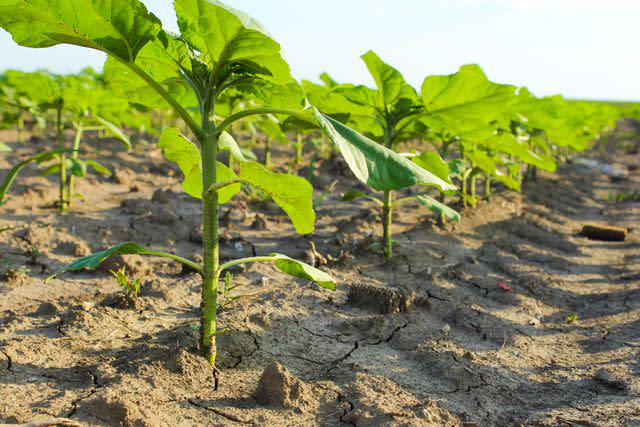
Zmaj88 / GETTY IMAGES
Sunflowers are one of the easiest crops to grow in your garden. "They also grow surprisingly fast—you won't need to wait long for significant growth and colorful blooms," says Meager.
Sunlight
Sunflowers, of course, thrive in full sunlight. The more direct sunlight you can offer them, the better. You'll also notice that sunflowers exhibit a remarkable heliotropic response; the flower heads follow the sun throughout the day.
Soil
You can grow sunflowers in most soil types, from clay and loam to sand mixes; amend dirt with backyard compost or fresh, crumbly organic matter for the best results. The main thing sunflowers won't tolerate is cold, hard, and compact soil.
Related: 10 Plants That Can Thrive in and Even Improve Compacted Soil
Water
Sunflowers appreciate a few inches of water weekly and offer the best seed harvest when hydrated regularly. However, the flower is remarkably drought resistant and can survive with much less water, says Meager.
Related: The Ultimate Garden Glossary: 28 Gardening Terms Beginners Should Know
How to Harvest Sunflower Seeds
Sunflowers reach full maturity in around three months, after which they're ready to harvest. You'll notice their colors start to brown; the seeds grow heavy and thick and feel loose. The flower head will also point towards the ground when the plant begins to wane and die. At this point, cut off the flower heads (roughly 1 foot below the petals) and hang them in a cool, dry area for a week.
To remove the seeds from the flower head, simply rub them; after drying for a week, they should pop right out. Work over a bucket to collect the cured seeds, which are perfect for snacking or baking.
Popular Types of Sunflowers to Grow
A little-known reason to plant multiple sunflower cultivars? It keeps your garden pollinators happy for longer. "Different sunflower varieties grow and blossom on different schedules," says Meager. "A diverse assortment keeps your garden buzzing with butterflies and bees—and booming with show-stopping colors all summer."
Here are five popular types of sunflowers to grow, according to Meager.
Mammoth Sunflowers
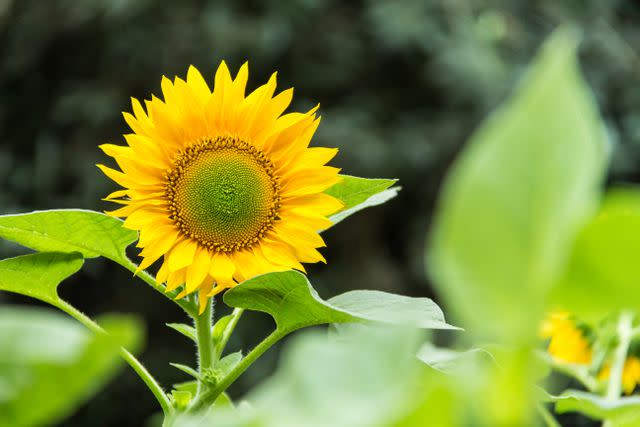
deschui / GETTY IMAGES
Mammoth sunflowers can reach up to 10 to 12 feet. The flowers are massive, flashy, and colorful.
Mature size: Up to 12 feet tall
Color: Yellow
Time to maturity: 85 to 100 days
Elf Sunflowers
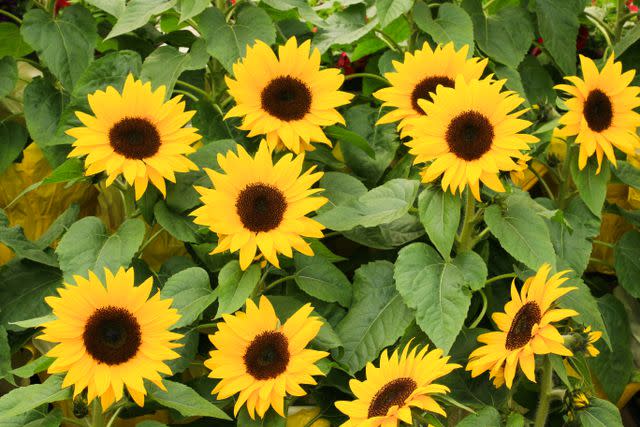
Clearphotov / GETTY IMAGES
On the other end of the spectrum are elf sunflower cultivars, which only grow 1 to 2 feet tall. They have yellow or orange blooms and look great in rock gardens or along walkways or front-yard picket fences.
Mature size: Up to 2 feet tall
Color: Yellow or orange
Time to maturity: 60 to 75 days
Moulin Rouge Sunflowers
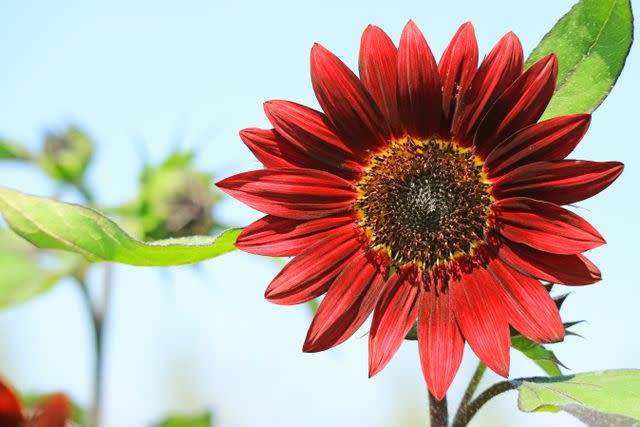
lovelypeace / GETTY IMAGES
Moulin Rouge sunflowers sport beautiful, burgundy-red flowers and are an excellent way to diversify your garden beds. Medium sized, they'll reach six feet at maturity. Grow them alongside yellow or orange sunflowers for a beautiful contrast.
Mature size: 6 feet tall
Color: burgundy
Time to maturity: 70 to 90 days
Strawberry Lemonade Sunflowers
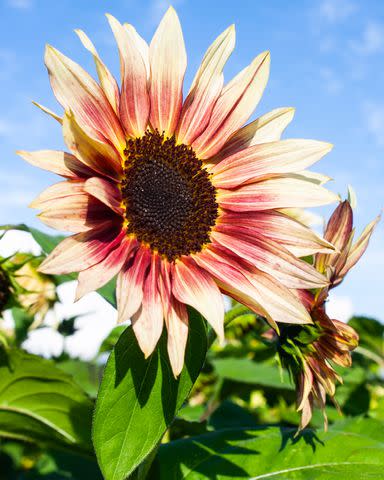
MissNephew / GETTY IMAGES
Strawberry lemonade sunflowers produce multi-colored flowers in shades of cream, pink, yellow, and red. They're roughly the same size as Moulin Rouge sunflowers.
Size: 5 to 6 feet tall
Color: multi-colored, featuring shades of pink, yellow, orange, and red
Time to maturity: 70 to 90 days
American Giant Sunflowers

Westend61 / GETTY IMAGES
The heavyweight champion of sunflowers is the American giant. This towering specimen reaches well over 13 feet tall and produces solid-yellow flowers up to 1 foot long. They're positively massive—and bees love them.
Mature size: Over 13 feet tall
Color: Bright yellow
Time to maturity: 75 to 90 days
Common Problems With Sunflowers
Sunflowers are famously easy to grow. However, you may experience a few easily fixable problems.
Lanky Growing Habit
If you grow jumbo sunflowers, stake them. "Sunflowers easily topple over—especially the taller and heavier cultivars," says Meager. "You'll want to secure them with wooden garden stakes and some garden twine as they reach 3 feet and upwards, especially if you anticipate lots of wind."
Insect and Animal Pests
A few unwelcome garden invaders famously attack sunflowers—and they're the usual suspects, like Japanese beetles, grasshoppers, aphids, stink bugs, and caterpillars. Aphids are easy to manage; mist them with the hose and watch them go flying. Keep larger insect pests, like stink bugs and Japanese beetles, at bay by manually plucking them from your sunflowers. Whatever you do, don't soak your sunflowers with insecticide, says Meager. You run the risk of injuring beneficial creatures who visit your sunflowers, like bumblebees, butterflies, and hummingbirds.
Generally, birds, deer, and rabbits are the three creatures that will wreak the most havoc on your sunflower crop—far more than any garden bug.
Month-by-Month Sunflower Grow Chart
Looking for an easy sunflower cheat sheet? Turn to our month-by-month grow chart, which will help you stay on track—but you won't have to do much. Sunflowers can flourish and blossom so long as there's no risk of frost and their seeds effortlessly germinate in soil temperatures of around 70 to 80 degrees Fahrenheit. They're the ultimate low-fuss flower, says Meager.
May | Late May is the perfect time to sow your sunflowers directly in your garden soil in many parts of the U.S. You can also begin germinating your sunflower seeds indoors in May. |
June | Early June is arguably the best time for sowing sunflower seeds directly into the soil. You can also safely transplant your baby sunflower plants outdoors at this time. Even if you planted some sunflowers in May, plant more in June. That way, you'll have a continued barrage of colorful flowers throughout the season. Plant new sunflower seeds every week in June for longer-lasting coverage and more bees. |
July | July is the last month to sow new sunflower seeds, says Meager. Most sunflower cultivars mature in around three months—and the first frost can occur in late September or early October in many U.S. locations. |
August | In August, your sunflowers will approach full maturity. You'll notice lovely blooms, deep flowering colors, and thick, heavy sunflower seeds. Sit back and enjoy the show. |
September | Most sunflowers will begin to fade by the end of September. Those not devoured by songbirds and deer can be harvested if you wish. |
